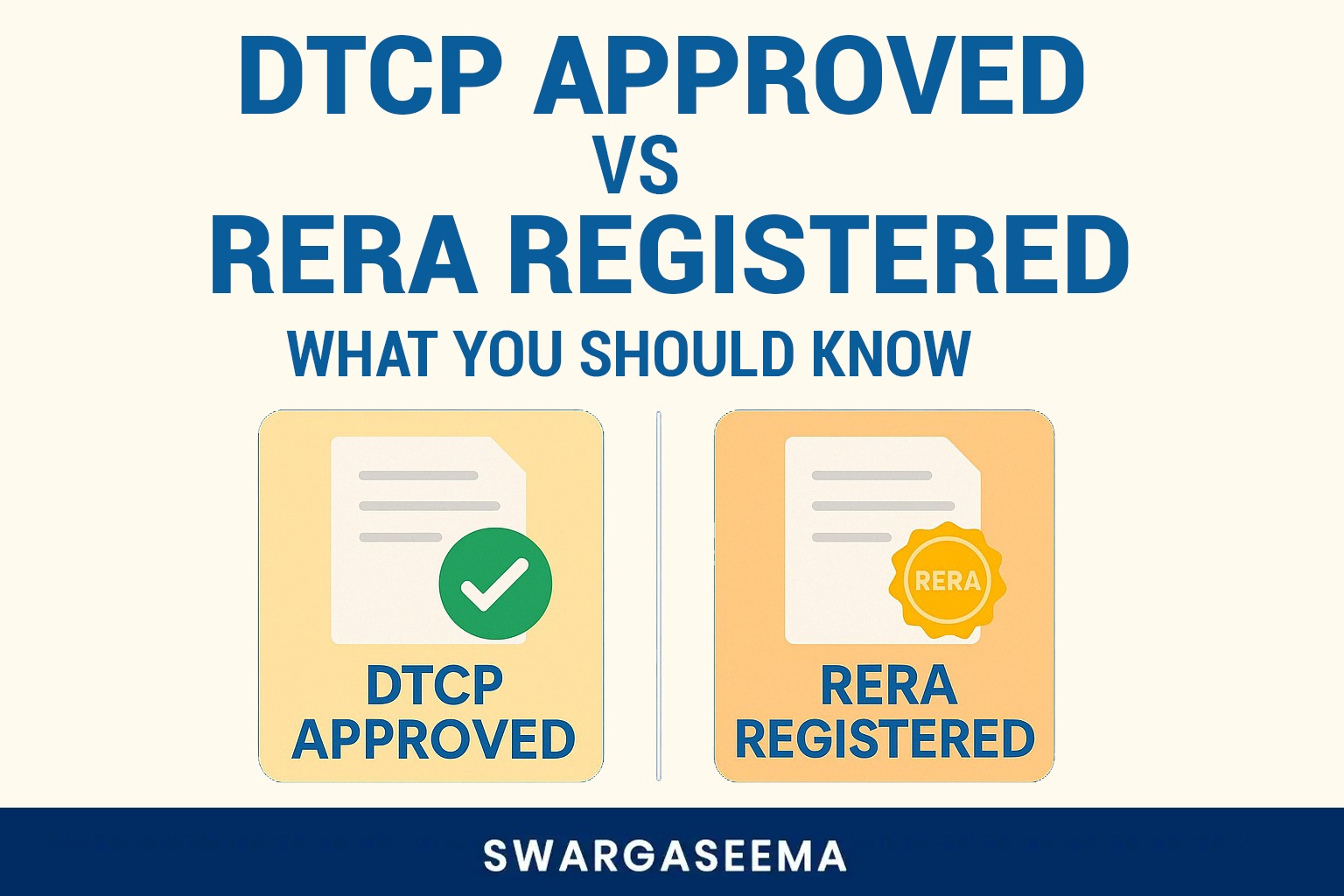DTCP Approved vs RERA Registered Ventures What You Should Know?
Nov 18, 2025 04:58 PM Admin
DTCP approval and RERA registration are two key pillars in the world of real estate that protect plot buyers and ensure transparent, safe investments. Understanding how each works and how they’re different will help you make wiser choices when buying a plot or home.
1. What Does DTCP Approved Mean?
DTCP stands for Directorate of Town and Country Planning. DTCP approval means the layout or plots has been officially cleared by the government for safe residential or commercial use. This isn’t just a stamp it’s confirmation from state planning authorities that the plot follows proper land use, zoning, and infrastructure guidelines (like parks, roads, drainage, and water connections).
When a venture is DTCP Approved, it means:
- The layout is officially approved by the DTCP department (government).
- The plotting, internal roads, open spaces, and width of roads follow government guidelines.
- The developer has permission to sell the plots.
Why DTCP Approval Matters
- Ensures the layout is legal protects buyers from owning plots in disputed or “no-build” zones.
- Protects buyers from unauthorized or unplanned layouts.
- Confirms that the developer cannot change the layout without permission.
- Avoids future problems like government demolition or legal hassles.
Documents Usually Involved
- Sale deed / ownership documents.
- Encumbrance certificate (shows there are no legal issues).
- DTCP layout approval letter.
- Final layout plan.
- No Objection Certificate (NOC) from environment or municipal authorities.
- Tax receipts from the local body.
2. What Does RERA Registered Mean?
RERA stands for Real Estate Regulatory Authority. It is governed by The Real Estate (Regulation and Development) Act, 2016 and implemented by state authorities to regulate the real estate sector, protect consumers, and increase transparency. If a project is RERA registered, the developer must follow strict rules for advertised promises, timely delivery, and disclosure of all project facts.
A RERA Registered venture means:
- The developer has registered the project on the RERA portal.
- All details such as project size, timeline, approvals, and developer information are officially declared.
- The developer is legally bound to follow the commitments listed in RERA.
Why RERA Registration Matters
- Assures buyers that all legal approvals (including DTCP) are in place.
- Allows complaints to be raised for delays, defects, or cheating.
- Pushes builders to deposit buyer money only for construction (escrow protection).
- Transparency — every detail is visible online, including approvals, carpet area, and progress updates.
- Ensures accountability from the developer.
3. Key Differences Between DTCP Approved & RERA Registered Ventures
| Feature | DTCP Approval | RERA Registration |
|---|---|---|
| Approval Authority | State Town & Country Planning Department (local planning authority) | Real Estate Regulatory Authority (RERA) |
| What It Covers | Land use, layout, roads, basic infrastructure for plots | Entire project details, builder, timelines, funds, disclosures |
| Compliance | Zoning, layout and infrastructure rules | Timely delivery, transparency, buyer rights and obligations |
| Buyer Protection | Basic legal safety — prevents encumbrances and illegal layout | Complaint platform, refunds, compensation & escrow protections |
| Transparency | Government certificate but limited public details | Full online project data, progress updates and public records |
| Legal Safeguards | Prevents illegal layouts and planning fraud | Ensures delivery, penalizes erring builders and enforces disclosures |
4. Which Is Better for Plot Buyers?
Both matter, but in different ways:
- If you want legal clarity of the layout → DTCP approved is essential.
- If you want transparency and accountability from the developer → RERA registered is important.
Best Option: Choose ventures that are both DTCP approved and RERA registered. Ideally look for fully developed ventures where infrastructure and documentation are already in place this gives you both legal safety and transparency.
5. Common Myths Buyers Have
- Myth 1: DTCP approval alone is enough for safety
- Reality: DTCP ensures layout legality, but RERA protects you from developer-side risks like delays, defaults, or broken promises.
- Myth 2: RERA is only for big projects
- Reality: Many plotting ventures also fall under RERA always check the RERA portal for your state to confirm.
6. Checklist Before Buying Any Plot
Use this quick checklist to stay safe:
- Check if the venture is DTCP approved & RERA registered.
- Verify title documents: sale deed, encumbrance certificate, tax receipts, layout plan, NOC, and all title documents.
- Confirm the developer’s track record past projects, references and site visits.
- Check approach roads, infrastructure, and surrounding developments.
- Investigate builder credibility: visit the site, check past projects, and ask for references.
- If in doubt, consult a civil lawyer to verify documents and approvals.
- Avoid ventures that promise unrealistic prices or instant returns.
7. Conclusion
Both DTCP approval and RERA registration are important for anyone planning to buy a plot. DTCP ensures the layout is legally approved, while RERA ensures transparency and buyer protection. A venture that offers both preferably a fully developed venture with clear documentation will give you more confidence and a smoother buying process.
